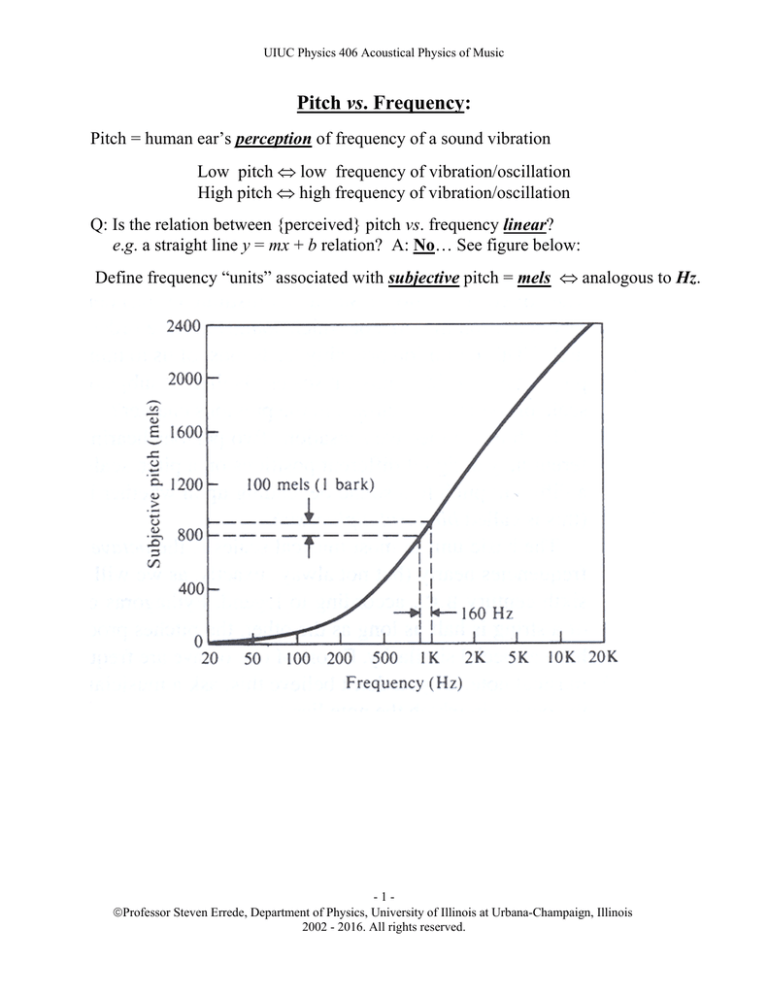
UIUC Physics 406 Acoustical Physics of Music
Pitch vs. Frequency:
Pitch = human ear’s perception of frequency of a sound vibration
Low pitch low frequency of vibration/oscillation
High pitch high frequency of vibration/oscillation
Q: Is the relation between {perceived} pitch vs. frequency linear?
e.g. a straight line y = mx + b relation? A: No… See figure below:
Define frequency “units” associated with subjective pitch = mels analogous to Hz.
-1Professor Steven Errede, Department of Physics, University of Illinois at Urbana-Champaign, Illinois
2002 - 2016. All rights reserved.
UIUC Physics 406 Acoustical Physics of Music
The Audible Frequency Range of Human Hearing (when young):
20 Hz < f < 20 KHz
( 3 orders of magnitude)
As we grow older, the ange of frequencies that we can hear decreases
(both high and low frequencies – mostly on the high frequency end…)
Frequency ranges of musical instruments typically ~ 100 Hz to ~ few KHz
e.g. guitar
Low E = 82 Hz
High E = 330 Hz
Piano highest note is ~ 4200 Hz
Very little above ~ 10 KHz
(squeals & scrapes)
The human ear needs to be able to perceive a sound for minimum length of time
t . In order to determine a pitch – i.e. pure/single-frequency tone – the minimum
duration time t of the pure tone depends on its frequency:
For f ~ 100 Hz (t ~ 10 msec): tmin ~ 40 msec (~ 4 cycles)
For f ~ 1000 Hz (t £ 1 msec ): tmin ~ 13 msec (~ 13 cycles)
The minimum duration time t for human perception of a pitch is certainly in
part due our ear & brain processing, but for low frequencies especially, minimum
time duration is also due to the uncertainty principle f t 1 , which tells us that a
pure tone/single-frequency sine wave signal of finite duration t in fact has a
finite frequency spread f ! Only as the time duration t does f 0.
-2Professor Steven Errede, Department of Physics, University of Illinois at Urbana-Champaign, Illinois
2002 - 2016. All rights reserved.
UIUC Physics 406 Acoustical Physics of Music
This can be seen by taking the Fourier transform of a finite-length {time
duration to } pure-tone/single frequency { f f o } time domain sinusoidal signal
p t po sin ot to the frequency domain p f :
If p t po sin ot po sin 2 f ot for t 12 to , and: p t 0 for t 12 to , and
defining the {rectangular} window function w t 1 0 for t 12 to t 12 to ,
respectively, then:
p f
t
t
p t sin t dt po
t
t
w t sin ot sin t dt po
t 12 to
t 12 to
sin o t sin t dt
Using the trigonometric identity sin A sin B 12 cos A B cos A B :
p f 12 po
t 12 to
t 12 to
1
1
sin 2 o to sin 2 o to
1
cos o t cos o t dt 12 po to 1
2 o to
2 o to
sin x
{n.b. sinc 0 1 }, hence we can write p f as:
x
p f 12 po to sinc 12 o to sinc 12 o to
The sinc function sinc x
The power spectral density functions S pp f p f (a frequency domain
quantity) for infinite length and finite length sine-wave signals are shown below:
2
-3Professor Steven Errede, Department of Physics, University of Illinois at Urbana-Champaign, Illinois
2002 - 2016. All rights reserved.
UIUC Physics 406 Acoustical Physics of Music
The sinc function sinc 12 o to sin 12 o to 12 o to for sinewave signals of {short} time duration to 1 o , 2 o ,3 o , 4 o where o 1 f o and the
corresponding # of cycles of oscillation N c to o 1, 2,3, 4 are shown in the figure
below. Note that the width f o of the main peak (at f f o ) depends inversely on the
time duration to of the signal, due to the uncertainty principle f t 1 .
-4Professor Steven Errede, Department of Physics, University of Illinois at Urbana-Champaign, Illinois
2002 - 2016. All rights reserved.
UIUC Physics 406 Acoustical Physics of Music
Human perception of pitch also depends {~ weakly} on the loudness of the sound.
* Effect arises due to non-linearities in the f & I response of the human ear.
* Pitch (perceived f) changes as loudness increases – see graph below...
* Effect exists only for pure/simple tones (!!!)
* Complex tones show no perceived pitch changes with loudness! (why??)
Two ears of same person may NOT perceive sound of a given frequency as having
the same pitch!!! = DIPLACUSIS – happens only for diseased, and/or injured ears.
For normal musical purposes, frequency and pitch are synonymous (usually)
n.b. applies only to periodic sounds.
Sound pulses are made up of a continuum of frequencies, sound pulses are thus
anharmonic and hence have no characteristic frequency and/or pitch.
-5Professor Steven Errede, Department of Physics, University of Illinois at Urbana-Champaign, Illinois
2002 - 2016. All rights reserved.
UIUC Physics 406 Acoustical Physics of Music
The human ear can discriminate changes in sound intensity levels/sound pressure
levels/loudnesses of JND L L1 L2 ~1/2 dB; Our ability to do so also depends
on frequency and sound pressure level/loudness:
A JND ~1/2 dB change in sound intensity level corresponds to a fractional
change in sound intensity of I /I ~ 12%. Thus, due to the ~ logarithmic response
of the human ear, it is not terribly sensitive to changes in the loudness of sounds.
-6Professor Steven Errede, Department of Physics, University of Illinois at Urbana-Champaign, Illinois
2002 - 2016. All rights reserved.
UIUC Physics 406 Acoustical Physics of Music
The typical human ear can discern changes in pitch/frequency at the f ~ 3 Hz
level in the frequency range ~ 30 Hz £ f £ 1000 Hz. Again, has frequency dependence:
Note that:
At very low frequencies:
Df f 3 30 = 10% ( 2 semitones) ,
Whereas at higher frequencies: Df f 3 1000 = 0.3% ( 0.1 semitones)
A good musician can discern frequency changes significantly smaller than this –
e.g. above f 500 Hz: 0.03 semitone (i.e. Df f 1 1000 = 0.1% )!!!
The human ear/brain is capable of detecting small changes in frequency!!!
-7Professor Steven Errede, Department of Physics, University of Illinois at Urbana-Champaign, Illinois
2002 - 2016. All rights reserved.
UIUC Physics 406 Acoustical Physics of Music
The human ear/brain is capable of perceiving a fundamental even when no
fundamental is actually present!!! This is the so-called missing fundamental effect.
This effect is {again} a consequence of the non-linear response in/inside the
human ear itself, and/or a non-linear response(s) in the human brain’s processing
of frequency information – whenever e.g. a quadratic non-linear response exists
(in any system), if two signals A and B with frequencies fA and fB are input to that
system, then sum and difference frequencies (fA+ fB) and |fA – fB| are produced!
Thus, e.g. a 2nd harmonic 2f1 and a 3rd harmonic 3f1 can produce a “missing”
fundamental from the difference frequency, |3f1 –2f1| = f1 !!! For further details on
distortion, read Physics 406 Lecture Notes on “Theory of Distortion I & II”.
For some musical instruments – e.g. the trumpet, the oboe and/or the
bassoon – the 2nd (or even 3rd and higher) harmonics can actually have a larger
amplitude than that of the fundamental, however we perceive/hear the “note” that
is played on the trumpet (and/or oboe, bassoon) as that of the fundamental!!!
The harmonic spectra – aka power spectral density functions S pp f vs. f and
associated {time-averaged} relative phase harmonic phasor plots are shown below –
e.g. for the steadily-played notes A4 (440.0 Hz) played on the oboe, and F2 (87.3
Hz) played on the bassoon:
-8Professor Steven Errede, Department of Physics, University of Illinois at Urbana-Champaign, Illinois
2002 - 2016. All rights reserved.
UIUC Physics 406 Acoustical Physics of Music
Note that the vertical axes of S pp f vs. f are displayed on a logarithmic scale.
-9Professor Steven Errede, Department of Physics, University of Illinois at Urbana-Champaign, Illinois
2002 - 2016. All rights reserved.
UIUC Physics 406 Acoustical Physics of Music
Legal Disclaimer and Copyright Notice:
Legal Disclaimer:
The author specifically disclaims legal responsibility for any loss of profit, or any
consequential, incidental, and/or other damages resulting from the mis-use of information
contained in this document. The author has made every effort possible to ensure that the
information contained in this document is factually and technically accurate and correct.
Copyright Notice:
The contents of this document are protected under both United States of America and
International Copyright Laws. No portion of this document may be reproduced in any manner for
commercial use without prior written permission from the author of this document. The author
grants permission for the use of information contained in this document for private, noncommercial purposes only.
- 10 Professor Steven Errede, Department of Physics, University of Illinois at Urbana-Champaign, Illinois
2002 - 2016. All rights reserved.



